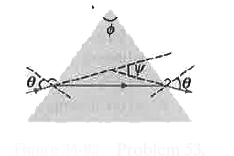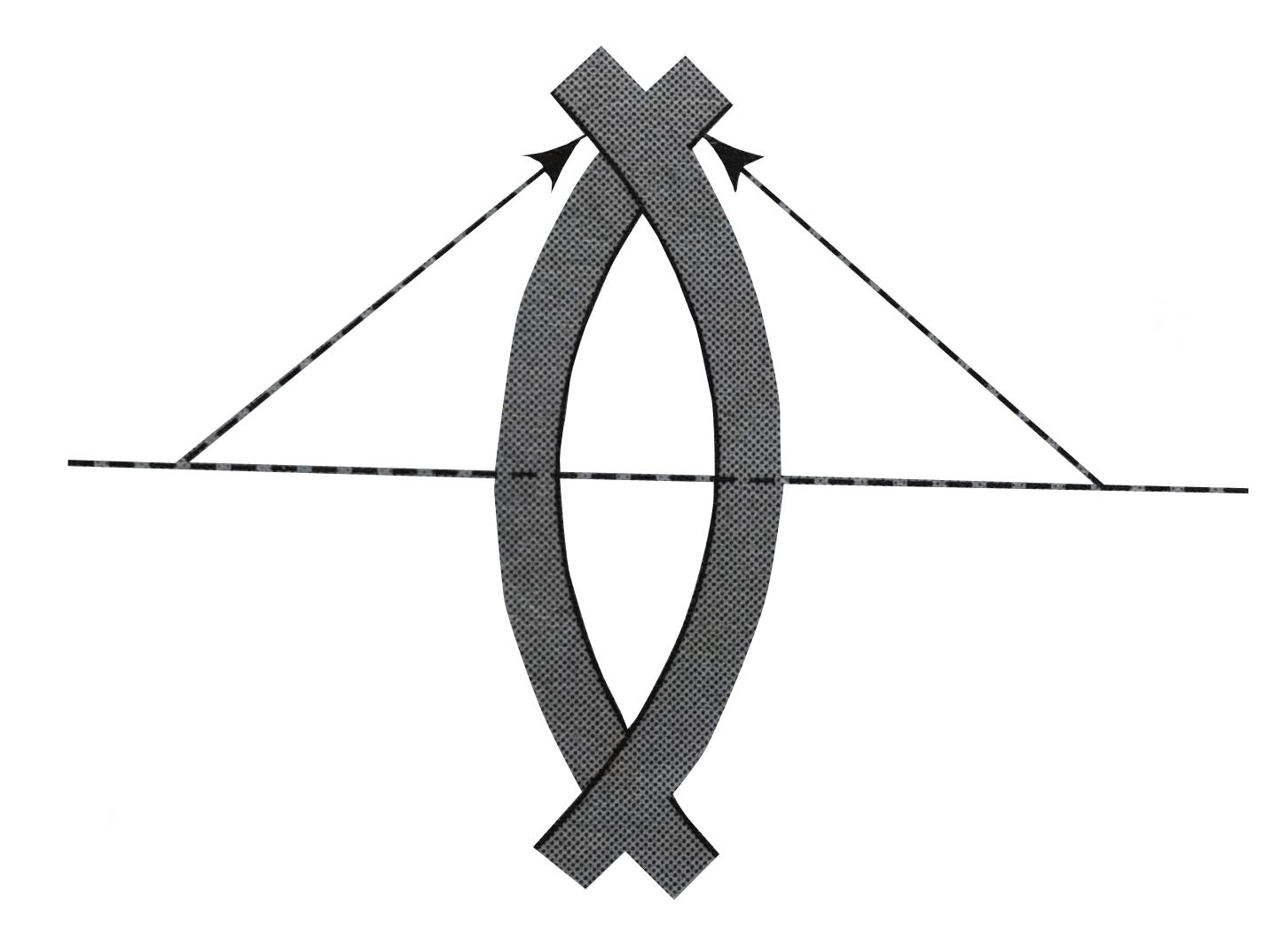Problems from RESNICK AND HALLIDAY PHYSICS Chapter 18 GEOMETRICAL OPTICS : REFRACTION for Class 12
| Class 12 | PHYSICS |
| Chapter | GEOMETRICAL OPTICS : REFRACTION |
| RESNICK AND HALLIDAY PHYSICS | Problems |
| Medium | English |
| Academic Year | 2023-2024 |
Question 2
Light in vacuum is incident on the surface of a glass slab. In the vacuum the beam makes an angle of a glass slab. In the vacuum the beams makes an angle of 37∘ with the normal to the surface, while in the glass it makes an angle of 23.5∘ with the normal. What is the index of refraction of the glass ?View SolutionQuestion 8
A concave mirror of radius of curvature one meter is placed at the bottom of a tank of water. The mirror forms an image of the sun when it is directly overhead. Calculate the distance of the images from the mirror for (a) 80cm and (b) 40cm of water in the tank ( μ=4/3 for water)View SolutionQuestion 9
A slab of glass of refractive index 1.5 and thickness 3cm is placed with the faces perpendicular to the principle axis of a concave mirror. If the radius of curvature of the mirror is 10cm, the distance at which an object must be placed from the mirror so that the image coincides with the object is View SolutionQuestion 14
Two spherical-shaped equal-sized glass fishbowls filled with water are standing on the table. In the middle of each fishbowl a small fish is swimming. What will be the distance of the image as seen by another ? The refraction index of water is 43. Take radius =R and distance between the centres of fishbowls as 3R.View SolutionQuestion 15
When viewed normally through the flat surface the apparent thickness of a plano-covex lens appears to be 2mm. If the radius of curvature of the spherical surface is 10cm then find thickness of the lens when viewed from the curved surface. Refractive index of the glass is 1.5.View SolutionQuestion 23
A plano-convex lens of focal length 40cm and refractive index =1.5 is silvered at plane surface. (a) What will be its focal length in air ? (b) What will be the equivalent mirror behave like ? (c ) What will be its focal length when it is silvered at curved surface instead of being silvered at the plane surface ?View SolutionQuestion 24
A beam of light diverges from P on the axis of a convex lens and the after passing through the lens is reflected from the surface of a convex mirror. The reflected beam is brought to a focus by the lens at P itself. (a) Find the focal length of the lens. Given that the distance of the lens and the mirror is 10cm. The distance of P from the mirror is 30cm and the focal length of the mirror is 10cm.View SolutionQuestion 26
A thin equiconvex lens of refractive index 3/2 and radius of curvature 50cm is placed on a reflecting convex surface of radius of curvature 100cm. A point object is placed on the principle axis of the system such that its final image coincides with itself. Now few drops of a transparent liquid are placed between the mirror and lens such that final image of the object is at infinity. Find (a) the refractive index of the liquid used and (b the position of the object.View SolutionQuestion 27
The cross section of a glass prism μ=2 has the form of an isosceles right-angled triangle. It is submerged in a liquid of refractive index 1.2. A ray is incident on to one of the equal faces perpendicularly. What is the angle between the direction of incident ray and the ray that emerges from the prism ?View SolutionQuestion 29
A quartz glass prism of refracting angle 4∘ is to be combined with a crown glass prism to create a direct-vision prism combination . (a) Find the refracting angle of the crown prism. (b) Find the angular width of the spectrum found by the combination. (For crown glass μR=1.52, μv=1.56, and for quartz glass μR=1.70,μv=1.74).View SolutionQuestion 31
A small fish 0.4m below the surface of a lake, is viewed through a simple converging lens of focal length 3m. The lens is kept at 0.2m above the water surface such that the fish lies on the optical axis of the lens. Find the distance of the image of the fish from the lens as seen by the observer. The refractive index of water is 4/3.View SolutionQuestion 32
The dispersive powers of crown and flint glasses are 0.03 and 0.05 respectively. The refractive indices for yellow light for these glasses are 1.517 and 1.621 respectively. It is desired to form an achromatic combination of prism of crown and flint glasses which can produce a deviation of 1∘ in the yellow ray. Find the refracting angles of the two prisms needed. View SolutionQuestion 34
A flint glass prism and a crown glass prism are to be comblined in such a way that the deviation of the mean ray is zero. The refractive index of the flint glass for the mean ray is 1.62 and for the crown glass it is 1.518. If the angle of the flint glass prism is 6∘, what would be refracting angle of theView SolutionQuestion 39
Suppose the prism of Fig. 34-83 has apex angle ph=60.∘ and index of refraction n=1.60. (a) What is the smallest angle of incidence θ for which a ray can enter the left face of the prism and exit the right face ? (b) What angle of incidence θ is required for the ray to exit the prism with an identical angle θ for its refraction as it does in Fig. 34-83.
 View Solution
View SolutionQuestion 41
An object is placed at a certain distance from a screen. A convex lens of focal length 20cm is placed between the screen and the object. A real image is formed on the screen for two positions of the lens, which differ by a distance of 10cm. What is the distance of the object from the screen ?View SolutionQuestion 43
Two thin sysmmetrical lenses of different nature and of different material have equal raii of curvature R=15cm. The lenses are put close together and immersed in water (μw=4/3) . The focal length of the system ini water is 30cm. The difference between refractive indices of tthe two lenses isView Solution


